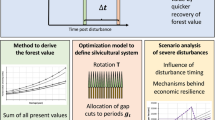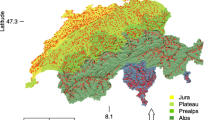Abstract
In this study, we explore the determinants of forest enterprises’ timber storage accumulation after severe storm events. The explanatory power of variables reflecting economic, institutional and tree species-related factors is tested via econometric analyses. Timber storage accumulation is assessed conducting a weighted multiple linear regression analysis. In addition, the moderating effect of timber price alterations on timber storage accumulation is tested employing timber price alterations as a moderator variable in a hierarchical regression analysis. The results show a linear positive relation between forest enterprises’ damaged and stored timber quantities. It was found that coniferous timber was stored to a greater extent than non-coniferous timber which can be explained by higher storm damage as well as better suitability for multiyear storage. State forestry stored the highest shares of damaged timber, followed by municipal and private forest enterprises, which can be explained as a countervailing measure. A further central finding of our study is that the timber price drops after storm events act as a moderator variable on the relation between damaged and stored timber quantities. Hence, empirical timber price reactions help to improve estimation accuracy regarding the shares of damaged timber which are stored. Derived from our results, we find timber storage accumulation to be a common practice by forest companies to mitigate revenue losses caused by extreme storm events. As coefficients vary strongly among the analyzed variables’ categories, we consider case-specific storage accumulation estimations to be crucial for improving the accuracy of national wood and timber accounting, but also for a full view on storm-related economic damage in the forest sector. In addition, it is likely that capturing the proportions of timber storage in forests will gain relevance in the future, since forest damage from natural disturbances is expected to increase as a consequence of climate change.

Source: special analysis at Forest Research Institute of Baden-Württemberg (FVA) based on an in-house management information system (FoFIS)



Similar content being viewed by others
References
Aiken LS, West SG (1991) Multiple regression. Testing and interpreting interactions. Sage Publication, Newbury Park
Backhaus K, Erichson B, Plinke W, Weiber R (2016) Multivariate Analysemethoden. Eine anwendungsorientierte Einführung. Lehrbuch, 14. überarbeitete und aktualisierte Auflage edn. Springer Gabler, Berlin
Bolte A, Ammer C, Löf M, Madsen P, Nabuurs GJ, Schall P, Spathelf P, Rock J (2009) Adaptive forest management in central Europe: climate change impacts, strategies and integrative concept. Scand J For Res 24:473–482. https://doi.org/10.1080/02827580903418224
Brunette M, Holecy J, Sedliak M, Tucek J, Hanewinkel M (2015) An actuarial model of forest insurance against multiple natural hazards in fir (Abies Alba Mill.) stands in Slovakia Forest. Policy Econ 55:46–57. https://doi.org/10.1016/j.forpol.2015.03.001
Carroll RJ, Ruppert D (1988) Transformation and weighting in regression. Chapman & Hall Ltd, London
Cuddeback G, Wilson E, Orme JG, Combs-Orme T (2004) Detecting and statistically correcting sample selection bias. J Soc Serv Res 30:19–33. https://doi.org/10.1300/J079v30n03_02
Dieter M, Rosin A, Thoroe C (2004) Die forstwirtschaftliche Gesamtrechnung der Bundesrepublik Deutschland im Rahmen des ESVG 1995 für die Jahre 1991 bis 2002. Arbeitsbericht des Instituts für Ökonomie; 2004/15. Institut für Ökonomie, Hamburg
Englert H, Seintsch B (2014) Aktualisierte Methodenbeschreibung zur Waldgesamtrechnung mit Tabellen für das Berichtsjahr 2012 (endgültig) und 2013 (vorläufig); Projektbericht für die umweltökonomischen Gesamtrechnungen des Statistischen Bundesamtes. Thünen-Institut für Internationale Waldwirtschaft und Forstökonomie, Hamburg, p 122
Gujarati DN (2003) Basic econometrics, 4th edn. McGraw-Hill, Boston
Hapla F (1992) Holzqualität von Kiefern aus einem Waldschadensgebiet nach fünfjähriger Naßlagerung. Holz als Roh-und Werkstoff 50(7–8):268–274
Hillmann M (2007) Kyrill—das Ende der Solidarität. AFZ Wald 62(22):1190–1191
Holecy J, Hanewinkel M (2006) A forest management risk insurance model and its application to coniferous stands in southwest Germany. For Policy Econ 8:161–174. https://doi.org/10.1016/j.forpol.2004.05.009
Institute SAS (2016) JMP 13 multivariate methods. SAS Institute, Cary
JMP (2017). http://www.jmp.com/support/help/Launch_the_Fit_Model_Platform.shtml#213135. Accessed 22 May 2017
Jochem D, Weimar H, Bösch M, Mantau U, Dieter M (2015) Estimation of wood removals and fellings in Germany: a calculation approach based on the amount of used roundwood. Eur J Forest Res 134:869–888. https://doi.org/10.1007/s10342-015-0896-9
Kinnucan HW (2016) Timber price dynamics after a natural disaster: Hurricane Hugo revisited. J For Econ 25:115–129. https://doi.org/10.1016/j.jfe.2016.09.002
Kish L (1965) Survey sampling. Wiley, New York
Lohner P, Appel V, Dieter M, Seintsch B (2016) Das TBN-Forst: Ein Datenschatz für die deutsche Forstwirtschaft, vol 17/2016
Mantau U (2015) Wood flow analysis: quantification of resource potentials, cascades and carbon effects. Biomass Bioenerg 79:28–38. https://doi.org/10.1016/j.biombioe.2014.08.013
McCarthy JJ, Canziani OF, Leary NA, Dokken DJ, White KS (eds) (2001) Climate change 2001: impacts, adaption and vulnerability. Contribution of working group II to the third assessment report of the intergovernmental panel on climate change. Cambridge University Press, Cambridge, p 1008
Neter J, Wasserman W, Kutner MH (1985) Applied linear statistical models. Regression, analysis of variance, and experimental designs, 2nd edn. Irwin, Homewood
NFI3 (2014) Der Wald in Deutschland. Ausgewählte Ergebnisse der dritten Bundeswaldinventur. Bundesministerium für Ernährung und Landwirtschaft, Berlin
Odenthal-Kahabka J (2004) Orkan “Lothar” - Bewältigung der Sturmschäden in den Wäldern Baden-Württembergs : Dokumentation, Analyse, Konsequenzen. Landesforstverwaltung, Stuttgart
Polley H (2006) The Second National Forest Inventory—NFI 2. Results; Covering the National Forest Inventory Surveys of 2001–2002 and 1986–1988. Federal Ministry of Food, Agriculture and Consumer Protection, Berlin
Riguelle S, Hébert J, Jourez B (2015) WIND-STORM: a decision support system for the strategic management of windthrow crises by the forest community. Forests 6:3412
Robinson C, Schumacker RE (2009) Interaction effects: centering, variance inflation factor, and interpretation issues. Mult Linear Regres Viewp 35:6–11
Schelhaas M-J, Nabuurs G-J, Schuck A (2003) Natural disturbances in the European forests in the 19th and 20th centuries. Glob Change Biol 9:1620–1633. https://doi.org/10.1046/j.1365-2486.2003.00684.x
Statistisches Bundesamt (2001) Agrarstrukturerhebung/Landwirtschaftszählung 1999. Metzler-Poeschel, Stuttgart
Thorn S, Bässler C, Svoboda M, Müller J (2017) Effects of natural disturbances and salvage logging on biodiversity–Lessons from the Bohemian Forest. For Ecol Manag 388:113–119. https://doi.org/10.1016/j.foreco.2016.06.006
ZMP-Marktbilanz Forst und Holz (2002) ZMP-Marktbilanz. Zentrale Markt- und Preisberichtstelle für Erzeugnisse der Land-, Forst- und Ernährungswirtschaft 2002
ZMP-Marktbilanz Forst und Holz (2008) ZMP-Marktbilanz. Zentrale Markt- und Preisberichtstelle für Erzeugnisse der Land-, Forst- und Ernährungswirtschaft 2008
Acknowledgements
Financial support by the Agency of Renewable Resources (FNR) under the auspices of the Federal Ministry of Food and Agriculture (BMEL) within the project Wood Resource Monitoring (“Rohstoffmonitoring Holz”) is gratefully acknowledged. We would like to thank Matthias Dieter for his continuous support, Niels Janzen for productive discussion, and Nils Ermisch, Emanuel Meier, and Wolfgang Hercher for the provision of data.
Funding
This study was funded by the Agency of Renewable Resources (FNR) within the project Wood Resource Monitoring (“Rohstoffmonitoring Holz”) (Grant Number 22021614).
Author information
Authors and Affiliations
Corresponding author
Ethics declarations
Conflict of interest
The authors declare that they have no conflict of interest.
Additional information
Communicated by Arne Nothdurft.
Rights and permissions
About this article
Cite this article
Zimmermann, K., Schuetz, T. & Weimar, H. Analysis and modeling of timber storage accumulation after severe storm events in Germany. Eur J Forest Res 137, 463–475 (2018). https://doi.org/10.1007/s10342-018-1116-1
Received:
Revised:
Accepted:
Published:
Issue Date:
DOI: https://doi.org/10.1007/s10342-018-1116-1




